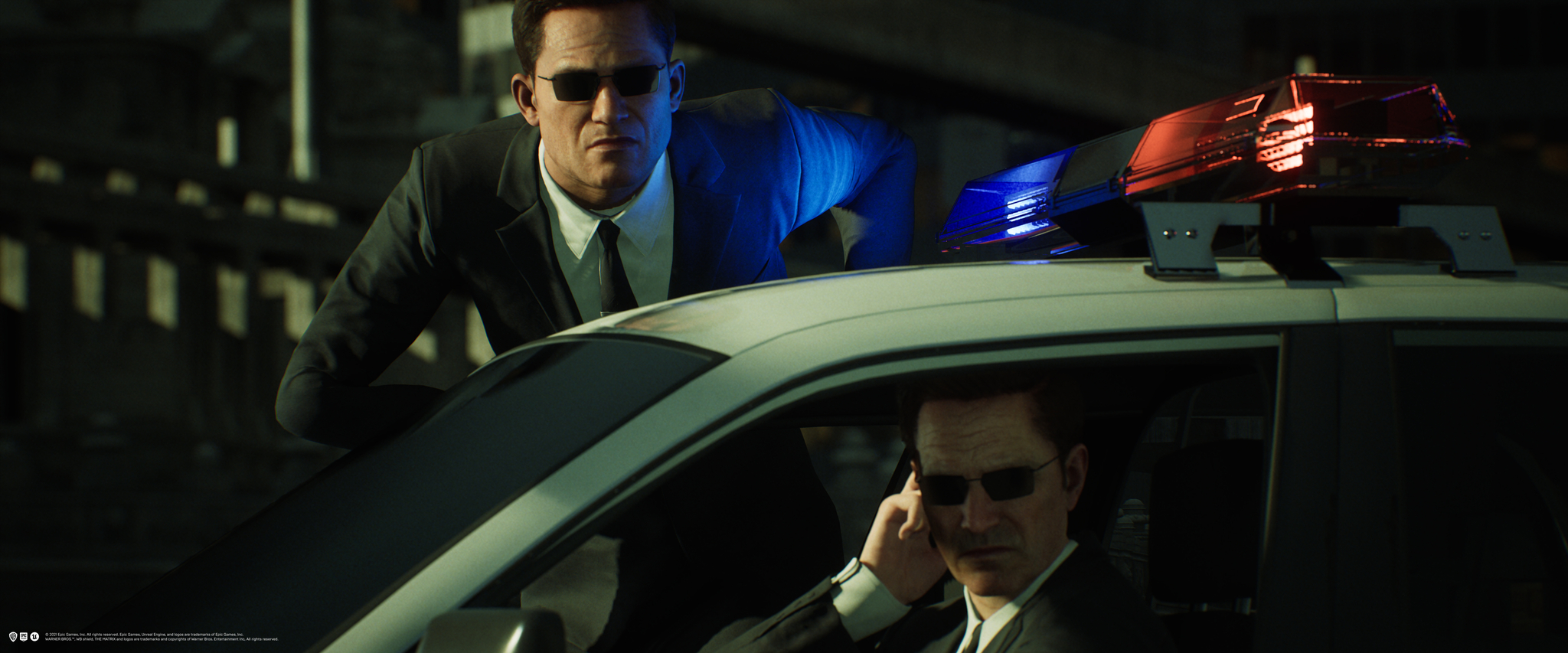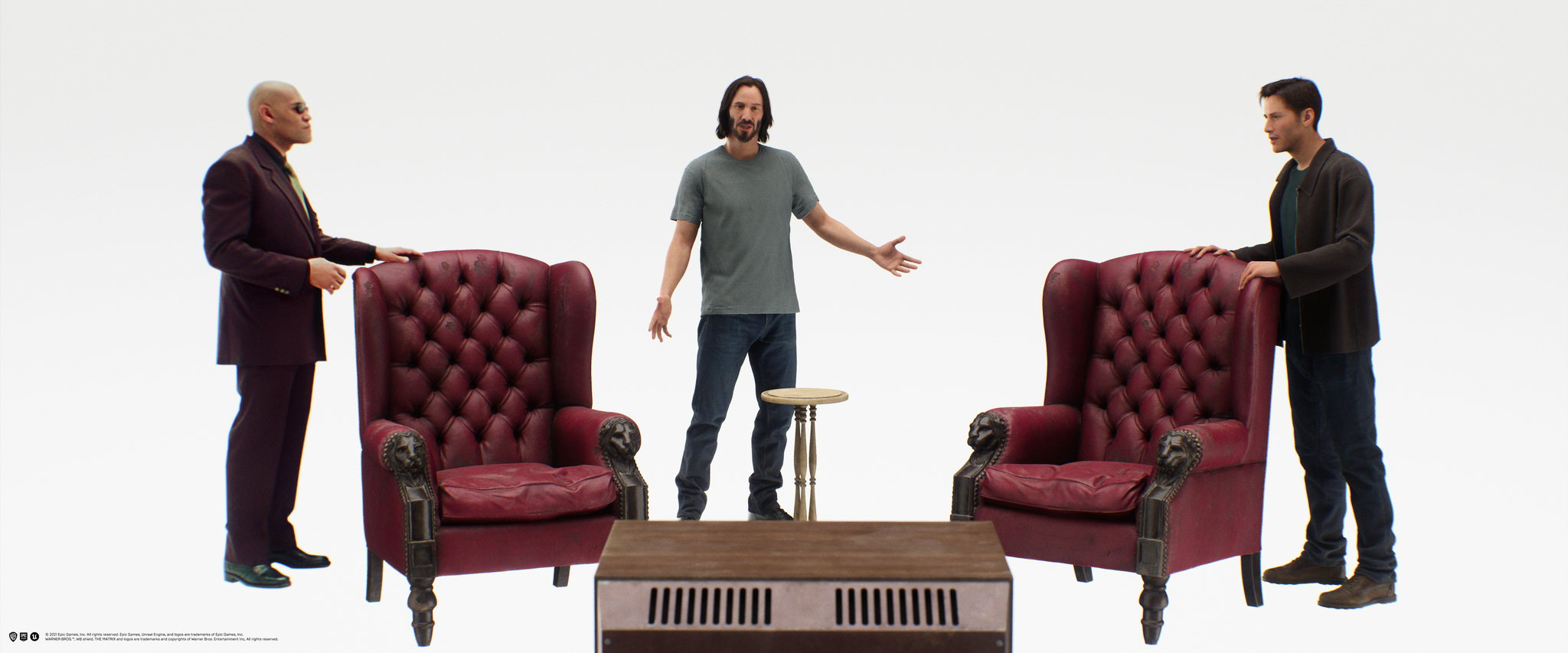A New Matrix Tech Demo Shows How Ridiculously Far Visual Effects Have Come
December 10, 2021Most of the attention paid to The Matrix Awakens: An Unreal Engine 5 Experience, a cheeky and technically impressive (but non-canonical) tie-in to the upcoming Matrix sequel, is likely to be around how digitally recreates actors Keanu Reeves and Carie-Ann Moss. It’s cool.
But for my money, the most impressive sequence in this elaborate demo actually involves an explosive chase on a highway. As cars driven by expressionless “agents” wearing black suits tumble and explode thanks to the player’s gun shots, it’s impossible to avoid thinking about the also (and still!) impressive highway sequence from 2003’s The Matrix Reloaded, a lengthy scene that involved the building of a legit 1.25 mile freeway in Alameda, California.
“I was part of making that movie, it was a nightmare,” joked Epic Games chief technical officer Kim Libreri in a recent interview. In another life, Libreri was visual effects supervisor on dozens of high-profile Hollywood productions, including the first three Matrix movies.
At a dinner years back, Libreri had dinner with Lana Wachowski, who revealed she was working on a new Matrix movie and wanted Libreri to work on the project. At the time, though, Libreri had already made the shift to Epic—the last Wachowski production Libreri worked on was Jupiter Ascending, and his final production was The Force Awakens—and politely declined. But Libreri still wanted to work with Lana and proposed merging worlds.
The Matrix is no stranger to video games; the Wachowskis were deeply involved in the design of multiple Matrix-related games, including Path of Neo and the MMO, Matrix Online. (For the latter, there’s speculation the reason Laurence Fishburne won’t appear in the new movie is because he was canonically killed during a story that played out in Matrix Online.)
That Libreri now works for Epic might’ve seemed odd 10 years ago, but no longer; the merging of Hollywood and video games is more than just hype. LucasFilms’ The Mandalorian, for example, heavily relies on Unreal Engine for its incredible-looking worlds, which can be altered and edited in real-time to accommodate creative shifts by the production, and The Mandalorian’s approach is likely to spread wider in the years ahead.
Libreri noted how when he and the rest of the crew on The Matrix Reloaded used tools to imagine what the scenes might look like before they were shot, often referred to as “pre-visualization.” But it was very hard to simulate what physical cars swerving and hitting each other would really do. The technology couldn’t pull it off, and so you were left guessing, even though the nature of making Hollywood movies means digital artists are frequently working on digital effects for scenes that have not yet been shot in the physical world yet.

“You've got these animators animating these car parts,” said Libreri, “and [on later on set] you're like, ‘Okay, stunt driver, off you go, that's what you need to do!’ And they'll be like, ‘Are you joking? We can't do that with a real car.’”
While shooting the highway sequence, they’d put pieces of tape on the fake highway, and ask the stunt drivers to drive between them, a way to help later merge the physical and the digital elements. But the drivers could never hit the tiny marks, and so the visual effects would be adjusted during post-production—the time after filming is over—to accommodate.
Compare this to the way Epic, who worked directly with Matrix co-creator Lana Wachowski, constructed this highway chase. Here, the car crashes aren’t meticulously scripted, they’re the result of a bunch of complicated systems interacting with one another to simulate a car crash. If a sequence doesn’t look exactly right, a designer can easily take direct control of any car in the scene, drive it exactly the way they want, and watch the scene unfold again.
And even then, many elements are driven by the player themselves. What cars explode and in what order is at the player’s discretion, and the technology takes care of how it all looks.
“The whole thing is this cinematic creation through simulation,” said Libreri. “It's almost like a live action? 50 years ago, when they shot Bullitt in San Francisco, they were using real worlds and real locations.”
1968’s Bullitt is famous for having one of cinema’s all-time—and genre-defining—chase scenes. It has a nearly 11-minute sequence filmed over three weeks that, despite the length of shooting, was forced to include shots where damage occurred to cars at points that didn’t make sense in the timeline, and required some very creative editing to hide the way a filmed explosion went off incorrectly during a stunt. Such ingenuity could be attributed to why a scene like that still holds up decades later, but it wasn’t how its designers planned it, either.
“The big difference now,” said Libreri, “is if we crash the car, or something doesn't quite work out to our tastes, it's very easy to do a reset—shake the dice and start again with something new and random.”
The layers of control allow for interesting realism, too. When filming Reloaded, Libreri said one piece of trickery audiences can’t see are stunt people hiding in the backseats of cars. When cars would crumble and crash on set, those same stunt people would be tossing buckets and buckets filled with glass—far more than a real car would actually shatter upon impact. In The Matrix Awakens, the glass shatters the appropriate amount for a single car.

For hardcore Matrix fans uninterested in the advancement of technology and what it means for the creative process, there are other reasons to download this showcase, too. The live action scenes with Reeves and Moss were, in fact, shot by Lana, who also wrote all the dialogue, despite the action being a riff on what the two characters were probably up to during the Reloaded era of the franchise and not a canonical story of their adventures.
The recreation of the original “bullet time” from The Matrix? Epic asked Warner Bros. to find the original digital files used to create the effects for that scene, so they could accurately recreate it. (There were plans to let players explore that space, but they ran out of time.) They also leveraged the original, Matrix-era face scans of Reeves for sequences that required showing a younger version of the actor, but had to invent something new: eyes.
“If you actually remember the movie, we never could do it [Reeves] digitally without sunglasses,” said Libreri, “the eyes were too hard in the year 2001, when we started working on that movie.”
They also had to re-create a younger Moss because she never underwent a similar face scan in that era.
“She was the hardest one to make,” he said. “Because in Reloaded, we never made a high resolution version of her face. But fortunately, Carrie-Anne has not changed a lot actually.”
During The Matrix Awakens, Reeves (Neo) and Moss (Trinity) meet a new character, an evolved version of IO, a character used to demonstrate Epic’s “metahumans,” a way to create incredibly realistic virtual characters to help eradicate the uncanny valley effect. IO has a new and very badass look here, partially because it’s a forgotten and never used costume designed for the original Matrix movie, now repurposed several decades later.
“Her costume was designed by my friend Kim Barrett, who was the costume designer on the first Matrix movie and the second Matrix movie,” said Libreri, “She's like, ‘Hey, I've got the perfect costume.’ She went into the archives and pulled out this drawing. ‘We never used it. Do you want to use this?’ And we're like, ‘Holy…yeah, yeah, absolutely.”
The Matrix Awakens is not quite Path of Neo 2, which is probably for the best. But part of The Matrix’s enduring legacy is its philosophical approach to the possibilities and limits of technology combined with leveraging the best possible technology at the time to convey those observations. Though The Matrix Awakens is more of an advertisement than a legitimate story, it’s a neat piece of work continuing the trailblazing that started back in 1999, and eerily suggests a real-life version of the “the matrix” is probably closer than we think.
Follow Patrick on Twitter. His email is patrick.klepek@vice.com, and available privately on Signal (224-707-1561).
